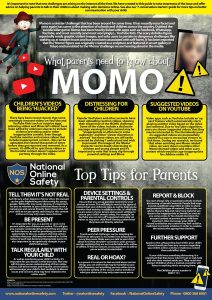The Momo Challenge “Hoax”
Originally posted on the Cambridge Skeptics Blog – March 1st 2019. Some small changes have been made as I was unable to source the original image I used.
The other day one of my work colleagues, like many parents across the country, received a disturbing email from his child’s school:
“We have been made aware of the dangers of a website link being shared on Whatsapp amongst the students called Momo. Apparently there are images and challenges which involve self-harm and stabbing people.”
It seems that evil was afoot, and coming for the children by way of social media. This evil goes by the name of “Momo” and sports frightening features reminiscent of demons from Japanese mythology. Momo allegedly pops up in the middle of your children’s favourite YouTube videos, and in Whatsapp comments, encouraging them to engage in such activities as taking pills, attacking other children, and even committing suicide. It also apparently warns them that, should they tell anyone about Momo, it will come to their house and kill them and their families. Scary stuff indeed.
One small problem, as I am sure most of you are no doubt aware by now, it simply isn’t true. The so called “Momo Challenge” is a hoax, unwittingly perpetuated by parents, teachers, and even the police, caught up in this latest moral panic, and fuelled by the understandable anxiety of trying to keep up with the ever changing face of the social media that their children indulge in every day. These concerns have then been picked up by the media, which in turn creates a vicious cycle, as Guardian media editor, Jim Waterson, explains:
“News coverage of the momo challenge is prompting schools or the police to warn about the supposed risks posed by the momo challenge, which has in turn produced more news stories warning about the challenge”
At this point a little background is probably in order. Back in mid 2018 the “Momo Game” was linked, in the media at least, to the suicide of a 12 year old girl near Buenos Aires in Argentina. Police confirmed that her death was likely the result of someone encouraging her to take her own life, but the closest they came to actually blaming the Momo Game was to suggest that the very real person involved may have done so “as part of a challenged(sic) aimed at crediting the Momo game” for the suicide.
Later, in August of that year, two more deaths in India were also linked to the Momo challenge, with an unnamed official stating:
“It (Momo challenge) is growing everyday. After the Blue Whale challenge, now we are facing this killer Momo Game Challenge. Links of this ‘game’ is getting circulated mostly through WhatsApp. We have alerted officials in the district to keep a tab on this matter…It is a growing menace and we are getting reports of an increasing number of people, mostly youths, getting invitation on their WhatsApp from unidentified numbers to play the ‘game'”
The reporting ramped up the fear, citing cyber expert Sandeep Sengupta, the managing director of the Indian School of Ethical Hacking:
“Administrators who are running the Game hack social media numbers of the players and blackmail them through other social networking sites…They keep a tab on the status people post on social networking sites and choose those who are showing suicidal tendency for sending them an invite to play the game.”
Concerns continued to grow in early 2019, as stories started to pop up on social media warning that Momo related content was being inserted into YouTube videos aimed at children, such as episodes of Peppa Pig and Fortnite gameplay videos.
This was met with a good deal of skepticism, as the evidence just didn’t seem to be there to support the claims being made. Youtuber ReignBot, famous for her videos looking into creepy things on the internet, stating that Momo’s presence on YouTube was really “akin to an urban legend”:
“People are claiming what Momo is and what Momo does, but not that many people have actually interacted with the account…Finding screenshots of interactions with Momo is nearly impossible and you’d think there’d be more for such a supposedly widespread thing.”
But despite this stories continued to appear, the fires being fanned by such reputable news sources as the Daily Mail and The Sun. All of which seems to have led to schools across the UK sending out worried emails, such as the one at the top of this post, and police issuing warnings.
But it’s all a hoax, right? So there is nothing to worry about? Heck, even the BBC, whose article on the subject was linked to in many of the emails sent out by schools, have updated their story to make it clear that the whole Momo thing is based on “false reports” which have been “amplified” by the media to create a “scare story”. So that’s the end of it right? We can all rest easy again. Well no, not really, because there are important lessons to be learned from all of this.
Social media is a massive part of the lives of most children these days, way more so than it was when most of you reading this blog were that age. New apps pop up all the time, it’s not all about Facebook any more. For example, how many of you know about TikTok? I certainly didn’t until I started researching this blog, but it is apparently one of the fastest growing apps in the world, being downloaded more times than Instagram last year, and with a core demographic of teens and younger.
And just yesterday it was fined a record $5.7 million by the FTC for collecting personal data on children under 13, amidst growing concerns that the app is being used by predators targeting children. And that is just one example, there are legitimate reasons to be concerned about what kids are accessing on the Internet.
Luckily there is also a lot of good advice out there on how to deal with these issues, and as such I want to end this blog by highlighting some of it.
Talk to your children about their online lives
As mentioned above social media and other online activities play a massive part in the lives of children these days, so make sure you talk to them about it as you would other parts of their lives. As the NSPCC put it:
“Having regular conversations about what your child is doing online – just like you would their day at school – is the best way to keep them safe.”
If your child feels they can freely talk to you about their online experiences then you are more likely to identify issues if they arise, and help them with any concerns they may have. Encourage them to tell you if they encounter anything that upsets or worries them so that you can deal with it together.
Be a part of their online lives
No, this doesn’t mean sending them friend requests for every app they use, but rather exploring the sites and apps your children use with them. Before you child starts using an app or website on their own, sit down with them and see what it is all about together. Let them know which sites you are happy for them to use, and which ones you have concerns about, and importantly why you have those concerns.
Help them understand what is and isn’t appropriate
When discussing with your child what you think is and isn’t appropriate online the NSPCC recommend asking them what they think. Ask them what sort of content they think is appropriate for children of different ages, and get them to explain to you why they think you might not approve of a given site or app. This way your children will feel much more involved in the decision making process, and better understand why they are not allowed to use specific apps and websites.
It is likely however that your children have friends who use apps and sites you don’t agree with and as such they probably disagree with your reasons for not allowing them to do likewise. Be sure to listen to them and discuss the points they raise. Also make sure they understand that this is not the final discussion on the matter, that as they get older, or you learn more about the app they want to use, you are willing to revisit the discussion.
Make sure they know how to use the Internet safely
I know I sound like a broken record here, but the NSPCC really do have some good advice on this, so good in fact that I struggled to work out a better way to work it…so I am not going to:
-
Talk to your child about what ‘personal information’ is – such as email address, full name, phone number, address and school name – and why it’s important.
-
Explain simple ways to protect privacy. For example, avoiding usernames like birthdates or locations that give away too much information.
-
Discuss images and photos, and what might be appropriate. Help your child understand how photographs can give people a sense of your personality, and that sharing the wrong kind of image can give the wrong impression.
-
Explain that it isn’t easy to identify someone online. People aren’t always who they say they are, so don’t share personal information. If it’s someone who genuinely knows your child, they shouldn’t need to ask for personal information online.
-
Tell your child that if they’re in any doubt they should talk to you first.
Understand the Tools that are available to you
Did you know that Fortnite comes complete with numerous in built tools to let you manage your child’s experience whilst playing, including how long they can access the game on a given day? Most people don’t. And Fortnite isn’t alone in this. Most apps and games that allow for online interaction come with some form of parental restrictions, and it is fairly easy to find out how to manage these online.
Related to this make sure your child is aware of how to manage the safety aspects of social media. Do they know how to report troubling content, how to block someone, and how to keep their private information safe? If not then show them how.
Be Skeptical
Last but by no means least, be skeptical. When stories like Momo come up be sure to look into them before immediately believing what you have heard. While it is often better to err on the side of caution, sharing incorrect information online can in and of itself cause harm. Stories like this cause people to panic and act in a reactionary fashion. They can also cause less savoury people to take advantage of the situation and engage in things like cyber bullying and online harassment. It pays to make sure that the information you are about to share is accurate before you hit send.


Leave a Reply